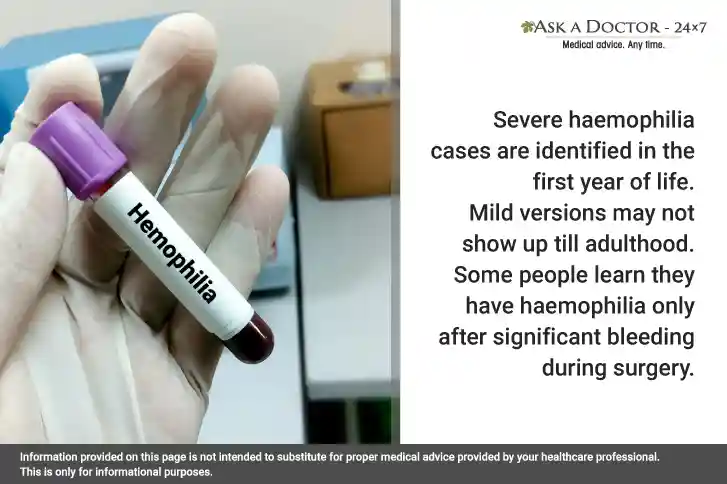If You Get Bruised Easily, You Must Learn About Haemophilia B
Have you ever noticed bruising appear on your skin without knowing how it happened? Although an occasional bruise from bumping into something might not be a major concern, frequent and inexplicable bruises could be a warning sign of something more serious. Haemophilia B is one of the illnesses that go undiagnosed until its symptoms worsen. It is a rare hereditary bleeding disorder that occurs when a gene that aids in blood coagulation alters or mutates.
Haemophilia B is associated with excessive bruising, nosebleeds, and spontaneous bleeding, which can be fatal if left untreated. If you experience easy bruising from minor injuries, or even when you aren’t aware of an injury, you should be vigilant! Let’s dive deeper to understand what Haemophilia B is and recognize its early warning signs before it leads to dangerous complications.
What is Haemophilia B?
Haemophilia B results from a lack of clotting factor IX, which can cause spontaneous bleeding and prolonged bleeding following an injury. This may show up as nosebleeds, bruises, or even bleeding into the muscles or joints.
Key Facts About Haemophilia
Here are the prime facts that one must know about haemophilia:
- Inherited disease: Haemophilia B is an inherited condition, meaning it is passed down from parents to their children.
- Deficiency in Factor IX: Clotting factor IX, which is necessary for blood clotting, is not produced in appropriate amounts by the body.
- Level of severity: Depending on the quantity of factor IX, haemophilia B can range in severity from mild to severe.
- No cure though treatment is available: This condition has no cure; hence, lifelong management is required to manage it, including preventing or reducing severe bleeding.
Symptoms of Haemophilia

The main symptom of haemophilia is effortless and excessive bleeding. Bleeding can take place at the following sites:
- Large and colorful bruising (skin discoloration from damaged, leaking blood vessels underneath your skin). Bruises fade as they heal, turning from blue or burgundy to green or yellow
- Bleeding into the muscle or soft tissues (hematoma)
- Bleeding from the gums and the mouth
- Blood in the urine or faeces
- Nosebleeds that are difficult to stop
- Bleeding following injections or immunizations
- Bleeding into the joints
Diagnosis & Treatment Planning For Haemophilia
Tests for clotting factors can identify a clotting-factor deficit and assess the severity of haemophilia. Also, genetic testing may be used to find carriers to help people with a family history of haemophilia and make educated decisions about getting pregnant.
Treating haemophilia involves episodic care to stop a bleeding episode when it occurs and prophylactic care to prevent bleeding episodes from occurring. The good news is that individuals with haemophilia B can live comparatively normal lives thanks to contemporary treatments. The main treatment involves replacement therapy, where the missing clotting factor IX is injected into the bloodstream to aid in proper blood clotting. While some people might only need therapy during surgeries or accidents, others can require infusions regularly.
In addition to medical care, lifestyle modifications can have a significant impact. Important measures include wearing protective gear during activities, keeping a healthy weight to lessen joint strain, and avoiding drugs that exacerbate bleeding, such as aspirin.
When To Call the Doctor
If you're unclear if an injury calls for the use of clotting factor concentrate or another treatment, don't be afraid to speak with your healthcare professional. Head and stomach injuries are more dangerous and should be discussed with your physician. Enquire with your physician about any bruises that persist beyond two weeks.
Additional indicators that you or a loved one could require medical care include:
- Bruises that cause pain or restrict a person's range of motion
- The head or neck being bruised
- Tingling, numbness, or lumps that worsen or don't go away
Conclusion
We have learnt so far that serious health problems may arise if abnormal bruising is ignored. A simple fall could develop into a medical emergency if proper clotting is not followed. If untreated, internal bleeding, particularly in vital regions like the brain or abdomen, can be fatal. If their bleeding condition is not timely diagnosed, people with haemophilia B may potentially experience difficulties following dental or surgical operations. Thus, it is essential to seek medical diagnosis from your healthcare provider, who would identify the symptoms early and have the necessary blood tests performed. You or a loved one may enjoy a longer, healthier, and worry-free life if you are proactive about your health.
If you have any questions related to bleeding disorders or Haemophilia, you can Ask an Internal Medicine Expert at Ask a Doctor - 24x7. To book an online consultation, you can click here.
Recently Answered Queries Related To Haemophilia
- What Causes Easy Bruising In An Elderly Person?
- Suggest a Cause And Treatment For Blood Cancer
- Having Hemophilia, Bilateral PCOS, And Bulky Ovaries. Proper Treatment?
- What Causes Numbness, Tightness, And Pain In The Face?
- Suggest Treatment For Acquired Hemophilia
- What Causes Multiple Bruises On The Legs And Arms?
- Nose Bleeds, Blood Test Done, APTT Slightly Prolonged, Thrombin Is Normal
- Suggest Ayurvedic Treatment For Blood Disorder
Disclaimer: Information provided on this page is not intended to substitute for proper medical advice provided by your healthcare professional. This is only for informational purposes.
Ask a Specialist
Recent Questions


